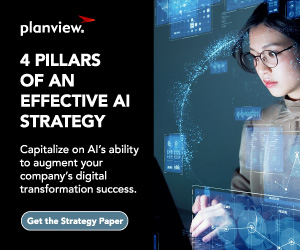
If AI poses one problem for leaders, it’s that there are too many opportunities.
How do you select the right path for your organization out of all the available paths while keeping AI use responsible and ethical? Pair these considerations with internal and external pressures to rapidly adopt generative AI and scale it, and leveraging AI is easier said than done.
To provide insight into those concerns, we spoke with a group of experts about AI’s challenges and opportunities. Here’s the experience that the panelists and moderator bring to the table:
- Sejal Amin, Chief Technology Officer at Shutterstock, stepped into her role in November 2022, just when Shutterstock was making their data deal with OpenAI. She’s led her team in bringing AI to the market throughout this turbulent year.
- Jana Eggers, CEO of Nara Logics, started as a research scientist and now helms the AI platform Nara Logics (and she joked with us that, surprisingly, it’s one that’s actually profitable).
- Razat Gaurav, CEO of Planview, has been a student of AI for nearly 30 years, leveraging it in his own work as a product manager and now exploring how generative AI can transform the way customers interact with Planview’s solutions via Planview Copilot.
- Dr. Rich Sonnenblick, Chief Data Scientist at Planview, started in old-school classical machine learning, and he’s exploring ways to implement it and generative AI into Planview’s solutions.
- Ray Wang, Principal Analyst and Founder of Constellation Research, coined the term “Metaverse Economy” in 2020. He is a leading authority on AI and AI policy.
During the conversation, the panelists spoke about five shifts that leaders should make if they want to effectively leverage AI.
1. Establish a Policy and Governance Framework for Using Data
Keeping a close eye on the data that AI is using is important to both you and your customers.
If you want to convey the message to customers that even while developing AI products, as Rich says, “we’re still being great data stewards, we’re being responsible with their data, and they are the primary beneficiary of that value,” you need governance over AI and data.
A data governance framework develops trust between you and your customers. Razat said, “As we are adopting these new technologies, we have to have a level of assurance that we are going to continue to provide this privacy and security that our customers expect.”
Further, a data policy builds trust by keeping quality high and accurate. Ray added, “You have ‘garbage in, garbage out’ scenarios here. So, if you don’t have really good input on your data, you’ll actually have really, really bad outputs.”
Read Next: Trends in AI: Should You View Data as a Product?
2. Orient Around Business Problems, not FOMO
Rather than picking up a tool just because it’s got AI in the name, begin with use cases.
Sejal advised starting small by finding a use case and then, either finding or building a tool to solve the problem, rather than the other way around. She adds, “It’s a much better way to tell a return-on-investment story because, at some point, you will have to tell a return-on-investment story.”
“You can’t wait for everything to get figured out and only then jump in, because it’s going to be too late.”
Razat Gaurav, Planview CEO
How do you know which use case to pick? Ray suggests it be one you can solve immediately rather than a broad use case that tries to boil the ocean.
For example, consider the value of getting access to insights buried in thousands of pages of internal documentation, or summarizing customer contracts and calling out unusual or unfavorable terms. Use cases like those can yield benefits in weeks, not months, says Rich.
Another example is to add an AI enhancement to customer-facing documentation, if it’s well organized: You can build an AI assistant on top of it in a few days with off-the-shelf tools offered by AWS/Amazon and others.
If you’re struggling, consulting an outside perspective can help narrow it down. Jana suggested working with an analyst to get an industry perspective on the entire picture.
3. Consider your Tech Stack
You’ve got the data, and you’ve got the use case, but you’ll also need to consider your technology.
It might be that the best way to address your use case is via a “daisy chain” (Sejal’s words) of tools.
Jana advised: “It’s not just a question of one tool, but how do you bring together different tools?” Whether that’s a grouping of AI tools or AI plus integrations with other tools in your tech stack, don’t leave tech out of your planning.
To hear more from the panelists about this topic, responsible AI, and improving decision-making and execution, listen to the full discussion: AI in the Enterprise: Opportunities, Challenges, and the Road Ahead.
4. Increase the AI Literacy of your Organization
We’re talking about artificial intelligence, but you can’t ignore the human side.
There’s a cultural aspect to introducing more AI, and the more transparent and educative you can be with your frontline employees, mid-tier managers, and leadership, the more effective your change management will be.
One benefit of the recent generative AI boom, even though, says Rich, “it’s not the be-all-end-all,” is that generative AI “can actually be a great gateway to explaining more traditional forms of machine learning and data-driven insights, and making AI accessible and understandable.”
Rather than having to review and interpret sophisticated machine learning techniques, employees can consume AI insights as explained by large language models like ChatGPT.
5. Create Room to Experiment
The last shift is all about making room to experiment with AI, whether that’s in terms of your budget or your priorities.
Razat warned against delaying AI for too long. He said, “You can’t wait for everything to get figured out and only then jump in, because it’s going to be too late. Because some of these movements are fairly disruptive, not just to your underlying customers, but also to your fundamental business model.”
Even if you’re not a particularly experimentation-friendly organization right now, there are ways to get there.
Sejal suggested that you may not always have to do a full market research exercise, especially if you have at least some research to start with and a use case selected. This way, you can get a capability to market quickly, test, and learn without risking too much.
Get More from AI in your Org
Gaining value from AI is possible, but it takes policy, planning, technology, education, and experimentation:
- Create a data governance framework for AI use.
- Start with the use case, not the tool.
- When you do get to tools, build a smart tech stack.
- Invest in educating your teams about AI.
- Overall, make room for experimentation.
Get more expert guidance on leading thriving companies in the Digital Age. Download the strategy paper, Building an AI Strategy for Digital Transformation Success, where you’ll learn the four pillars of an effective AI strategy and framework, how to draft a policy for using AI ethically and responsibly, and more.







